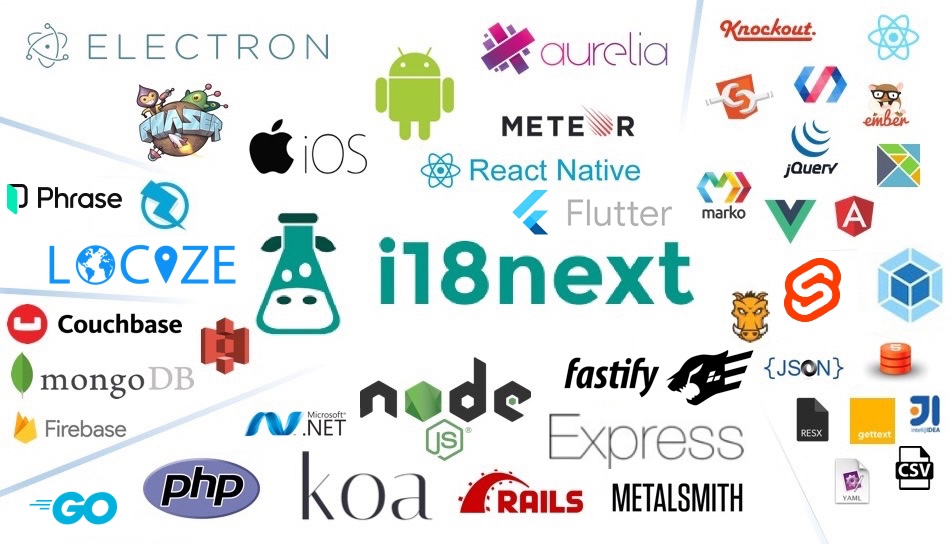Integration with Frameworks
- i18next:
i18next is highly versatile and can be integrated with almost any JavaScript framework, including React, Angular, and Vue. It offers plugins for seamless integration, making it a popular choice for multi-framework projects.
- react-intl:
react-intl is built specifically for React applications, providing a set of components and APIs that make it easy to format messages, dates, and numbers within the React ecosystem, enhancing the developer experience.
- vue-i18n:
vue-i18n is designed for Vue.js applications, offering deep integration with Vue's reactivity system. It allows for easy localization of Vue components and directives, making it the best choice for Vue developers.
- next-i18next:
next-i18next is specifically tailored for Next.js, providing a streamlined integration process that leverages Next.js features like server-side rendering and static site generation, ensuring optimal performance and user experience.
- @inlang/paraglide-js:
@inlang/paraglide-js is designed to work with various JavaScript frameworks, providing flexibility in integration. It allows developers to choose their preferred framework while still benefiting from its features.
Feature Set
- i18next:
i18next boasts a rich feature set, including support for interpolation, pluralization, context-based translations, and backend support for loading translations from various sources. It is highly configurable and extensible, making it suitable for complex applications.
- react-intl:
react-intl provides a comprehensive API for formatting messages, dates, and numbers, along with support for pluralization and rich text formatting. It is designed to work seamlessly within React components, making localization straightforward and efficient.
- vue-i18n:
vue-i18n offers a robust feature set for Vue.js applications, including support for nested translations, dynamic locale switching, and custom message formatting. It integrates well with Vue's reactivity system, ensuring smooth updates to localized content.
- next-i18next:
next-i18next simplifies the i18n setup for Next.js applications, offering features like automatic language detection, server-side rendering support, and easy integration with Next.js routing. It streamlines the i18n process without sacrificing functionality.
- @inlang/paraglide-js:
@inlang/paraglide-js offers a modern feature set focused on type safety, making it ideal for TypeScript users. It supports dynamic imports and provides a clean API for managing translations, but may lack some advanced features found in more established libraries.
Community and Support
- i18next:
i18next has a large and active community, providing extensive documentation, tutorials, and plugins. It is widely used in the industry, ensuring robust support and a wealth of resources for developers.
- react-intl:
react-intl is part of the FormatJS suite and has a strong community backing. It offers comprehensive documentation and resources, making it easy for developers to implement localization in their React applications.
- vue-i18n:
vue-i18n has a dedicated community within the Vue ecosystem, providing solid documentation and support. It is widely used among Vue developers, ensuring that resources and help are readily available.
- next-i18next:
next-i18next benefits from the popularity of Next.js and has a growing community. It is well-documented, making it easy for developers to find help and examples specific to Next.js applications.
- @inlang/paraglide-js:
@inlang/paraglide-js is relatively new and may have a smaller community compared to more established libraries. However, it is gaining traction and has good documentation to assist developers in getting started.
Performance
- i18next:
i18next is designed for performance, with features like lazy loading of translations and efficient caching mechanisms. However, complex configurations may require careful optimization to maintain performance in large applications.
- react-intl:
react-intl is optimized for React applications, ensuring that localized content is rendered efficiently. It minimizes re-renders by using React's built-in optimization techniques, providing good performance even in larger applications.
- vue-i18n:
vue-i18n is built with performance in mind, utilizing Vue's reactivity system to ensure that updates to localized content are efficient. It supports lazy loading of translations, helping to reduce initial load times.
- next-i18next:
next-i18next leverages Next.js's performance optimizations, ensuring that translations are loaded efficiently during server-side rendering. This results in fast initial page loads and a smooth user experience.
- @inlang/paraglide-js:
@inlang/paraglide-js is lightweight and optimized for performance, ensuring fast loading times and minimal overhead in applications. Its modern architecture allows for efficient handling of translations without impacting application speed.
Learning Curve
- i18next:
i18next has a moderate learning curve, with a wealth of features that may require some time to fully understand. However, its extensive documentation and community support help ease the learning process for new users.
- react-intl:
react-intl is relatively easy to learn for developers familiar with React. Its component-based approach aligns well with React's paradigms, making it intuitive to implement localization in React applications.
- vue-i18n:
vue-i18n is designed to be easy to use for Vue developers, with a clear API that integrates seamlessly with Vue's reactivity system. Developers can quickly learn to manage translations and localize their applications.
- next-i18next:
next-i18next is straightforward to learn for developers already familiar with Next.js. Its integration is simple, and the documentation provides clear guidance for implementing i18n in Next.js applications.
- @inlang/paraglide-js:
@inlang/paraglide-js has a gentle learning curve, especially for TypeScript users, due to its clear API and focus on type safety. Developers can quickly grasp its concepts and start implementing localization in their projects.























